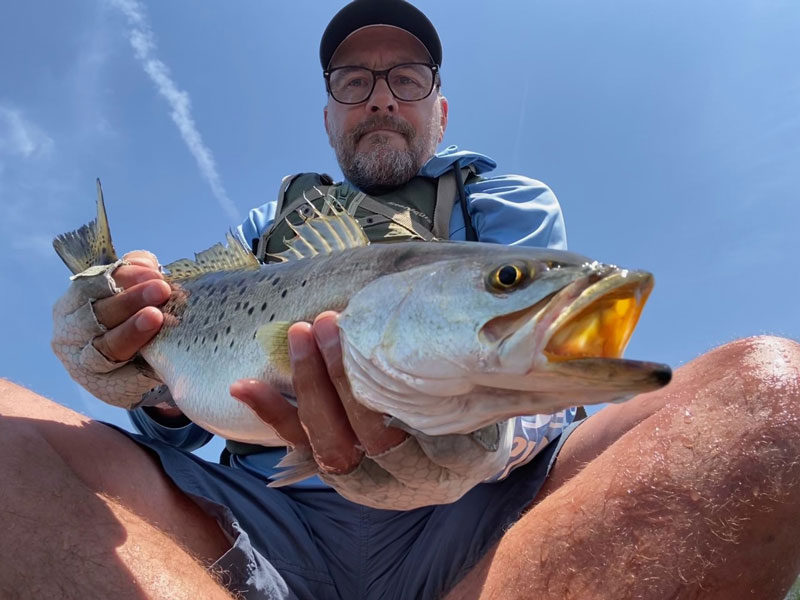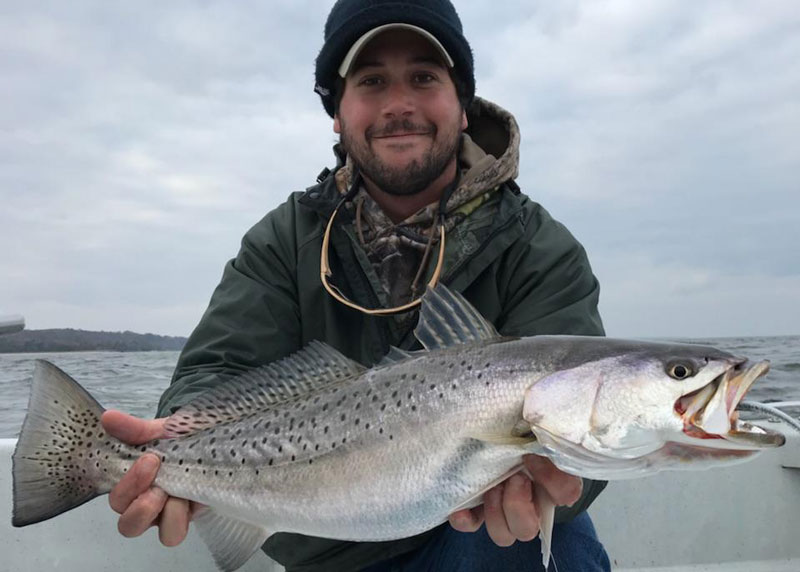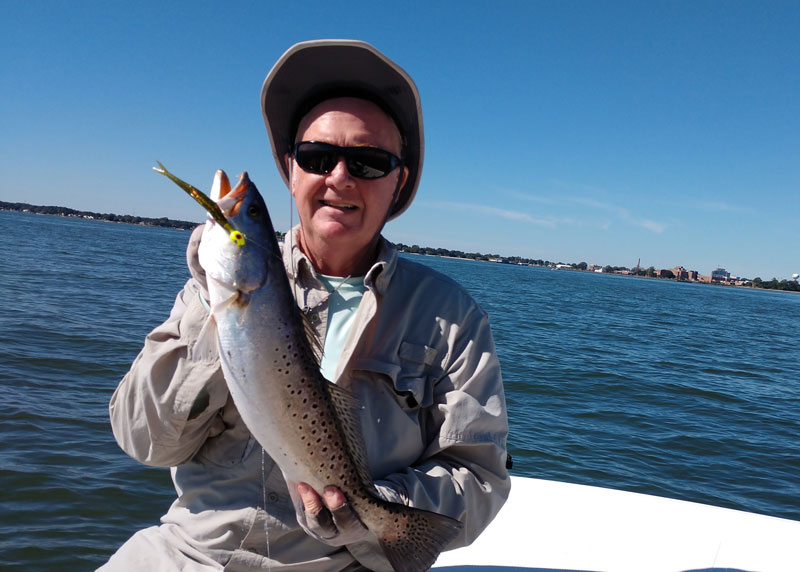Speckled sea trout are not pushovers. If you have read many of my articles you may have heard me say “Any fish, many fish, big fish, hard fish.” This is the progression most of us take as we get better at fishing. It starts with just wanting to catch a fish. Then it’s all about filling a cooler with a lot of fish. It progresses to catching a big fish, and then finally to landing a hard fish to catch. I would classify speckled trout (spotted sea trout) as a hard fish for most people to catch in our region — and catching large ones consistently is very hard.

My biggest speck was 27 inches. That’s a big one for our area. There are places where that is not as big a deal as it is for me, here. I typically think of any speck over 22 inches as big for our area. And like a lot of species, larger specks don’t always swim in the same waters nor fall for the same baits as smaller ones.
Seeking Specks
First let’s mention that unlike some species, the bigger speckled trout are often found in shallower water. A lot of my trout fishing is done in eight to 10 feet of water. When looking for a big one I often look for a shallow flat, sometimes less than three feet deep. You may not find a lot of specks this shallow in our area, but you just may find that big fish. There are flats around Hampton, Poquoson, and in the Elizabeth River, Lynnhaven River, and Rudee Inlet. In fact, flats may be found near most inlets leading into the Chesapeake Bay.
Top Speckled Trout Lures
When fishing in shallow water, you don’t have to worry about getting to the bottom as in deeper water. So, many of the best baits are somewhat lighter. Let’s begin at the surface and fishing topwater. Topwater plugs are very popular for specks in Florida and the same lures work here as well. A couple of popular lures are the Moonwalker and the Heddon Super Spook Jr. The Moonwalker is a four-inch bait developed by Salt Strong. It comes with a pair of single hooks. The Super Spook Jr. is a 3.5-inch lure that has been around for a very long time. It comes with treble hooks which can be easily switched for single hooks.
Both of these lures are designed for a “walk the dog” retrieve. In this retrieve you hold the rod tip low and pump it to cause the bait to move from side to side as it is retrieved along the surface. These baits will also catch a variety of other species and topwater strikes are exciting since you can see the fish hit the bait. Topwater lures work best in low light situations (early and late in the day).

Pop That Popping Cork
Moving to subsurface lures, our next bait is fished under a popping cork. When I started using popping corks, I thought they had to have a concave face to make a “popping” sound. However, the oval ones are actually preferred by a lot of people. These make plenty of commotion on the surface. These corks come rigged with a through-wire and beads to add some noise to the splash. The through-wire has loops at each end to attach the running line and the leader. The length of the leader depends on the depth of the water. It may be shorter than 18 inches, or up to a few feet long. The options for the business end of the leader include lightweight jig heads with plastic tails or weighted hooks with plastic tails. Weighted hooks such as Owner Weighted Twistlocks Hooks work well in shallow water applications (under popping corks or by themselves). By rigging the plastic tail so it is weedless, you will avoid picking up the eel grass that seems to be on most flats. Eel grass is a blessing as a place for fish and bait to hide. But it is a curse as it gets snagged on most types of lures.
Popping corks are typically worked with a quick jerk to make a splash and lift the bait, followed by a pause to allow the bait to settle back down. Keep your eye on the cork. The bite often comes as the bait is falling. Popping corks work best on a flat surface so if there is wind on the water, I leave the corks in the tackle bag.
Jigs and Plastics
If you are looking to catch your first speck, I would recommend working a half-ounce leadhead jig with a Gulp! Swimming Mullet in yellow or white. And, while that rig will sometimes catch a bigger speck, there are other baits that tend to do better. Leadhead jigs and weighted hooks are both used with plastic tails in a wide variety of shapes, sizes, and colors. As for shapes, there are four main ones: swimming, paddletail, shrimp, and jerk baits.
Paddletails are good baits in murky water since they put out a good vibration. These baits come in a variety of sizes. Both Salt Strong and Z-Man have big selections of paddle tails in different color patterns. Some of these will come impregnated with scent. Different brands are more expensive than others, with some costing as much as $10 a piece. Did I mention there are a lot of bluefish in our area that would love to dine on a bait that costs 10 bucks?
Shrimp type tails have much less action than paddletails, but on some days, they work well. Shrimp baits under a popping cork are especially effective.
Finally, jerk baits are plastic tails that don’t put out much vibration. They tend to be long and slender and imitate small fish darting along. On some days, especially in clear water, they will out-fish everything else. My absolute favorite is the Alabama Leprechaun from Salt Strong. I have caught quite a few specks over 20 inches with this bait. And remember that when targeting big specks, bigger plastics are often better. While smaller fish love three-inch tails, larger fish often prefer tails around five inches long.

Speckled trout tend to be fussy eaters, and they won’t bite just anything (which is why I put them in the “hard fish” category). I would recommend trying different lure combinations and sticking with what works for you on your favorite flat or special spot on any particular day. Just remember, tomorrow they may go for a totally different bait. That is what makes speck fishing fun!
Big Speckled Trout from a Kayak
Since big specks can be found in relatively shallow (and often protected) areas, this is a fishery where in many cases kayak anglers have just as good a shot at scoring big fish as boat anglers do. All of the same tackle and tactics the author talks about in this article apply. However, kayak anglers will also want to check out the following articles:
- Kayak Fishing for West Side Speckled Trout
- Paddler’s Edge Kayak Fishing: Specks and Redfish
- 5 Lower Bay Virginia Hotspots (which includes some launch points for kayakers)
-By Chuck Harrison